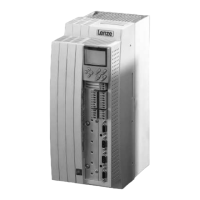Function library
7-57
L
EDSVS9332P-D21 EN 3.0
7.5.8.9 Homing mode 10 and 11
Purpose
•
Homing in absolute positioning mode (C1210 = 0, 2).
•
Use of touch probe if the index pulse does not appear at the same place in a reproducible
form due to the mechanical constellation. The index signal can also be mechanically shifted
after a motor exchange.
9300POS030
H o m e p o s i t i o n
T o u c h P r o b e
E n d o f t r a v e l s w i t c h
( P O S - L I M - P O S )
Mode 10: Traversing direction to positive POS-LIM-POS
Traverse in positive direction up to POS-LIM-POS, reverse there and reference to TP (case ). During
reversing the limit switch must always be assigned!
•
Move to positive end of travel range limit switch in positive direction with homing speed
C1242.
•
Reverse and move in negative direction to the reference point via touch probe with homing
speed C1242 or C1241 (depending on the setting in C1216, see second homing speed).
•
If the drive is positioned on the positive end of the travel range limit switch before homing, it
travels in negative direction (case ).
•
The reference point is at touch probe + home position C1227.
The fault P02 is not displayed!
Mode 11: Traversing direction to negative POS-LIM-NEG
Travel in negative direction up to POS-LIM-NEG, reverse there and reference to TP. TP can also be
thenegativeedgeofPOS-LIM-NEG.
Otherwise identical with mode 10
Tip!
In order to save initiators the limit switch (POS-LIM-xxx)can be simultaneously used as touch probe.
The TP input is selected under C1214.
Since the limit switches are factory-set to LOW active, select the rising edge for TP (C1215/x = 0).
After homing, the drive must not directly stop on the reference point, since this may result in a
response of the travel range limit switches. The reference limit point must be set accordingly.

